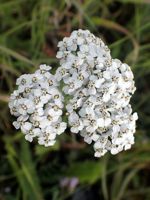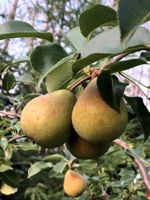Mon-Fri 9am - 5pm Mountain time
Yarrow vs Beedle Pear
Achillea borealis (Previously Achillea millefolium)
Pyrus Beedle
NOT AVAILABLE THIS SEASON
(new stock expected: fall of 2026)
Yarrow is a herbaceous, native wildflower that is found across Canada. It features large, flat clusters of tiny white flowers. The blooms attract a variety of pollinators, making it an ideal choice for pollinator gardens. While partial shade is tolerated, the best flowering occurs in full sun. Yarrow is resistant to deer and rabbits, making it both a beautiful and practical addition to your landscape.
The entire plant is edible, but leaves and flowers are most commonly consumed. They have a strong licorice scent and a mild sweet flavor that is similar to tarragon. Yarrow leaves can also be used as a natural insect repellent.
It is important to plant Yarrow in the right place, it can spread quickly via both rhizomes and self-seeding. Deadheading the spent flowers will extend the bloom season and can help limit self-seeding.
Beedle Pear is sweet, soft, and juicy with no astringency making it great for fresh eating. They typically ripen on the tree in early September. The medium-sized pears keep relatively well when compared to other varieties. For most years it is a reliable producer on the prairies.
The Beedle Pear is a cold hardy pear with Canadian roots. John Beedle discovered it on a city boulevard in St. Albert, Alberta.
For fruit production, another pear variety is required for cross-pollination. Can be paired with Krazulya Pear or Ussurian Pear.
Yarrow Quick Facts
Beedle Pear Quick Facts
Toxicity: toxic to dogs, cats, and horses

